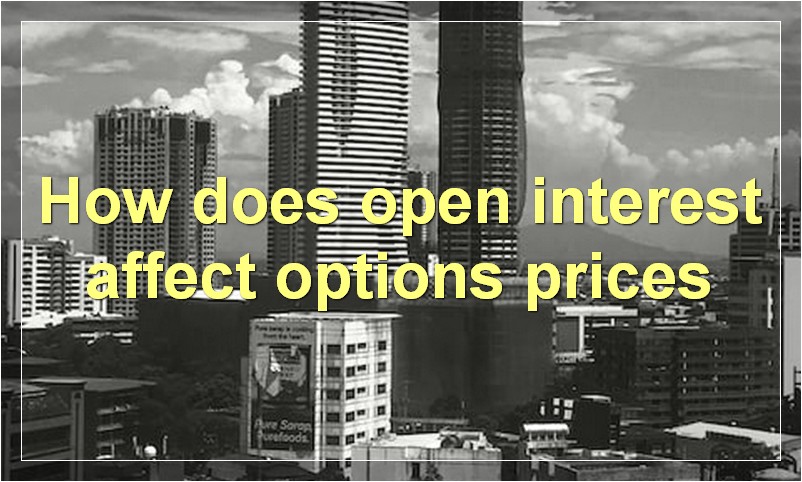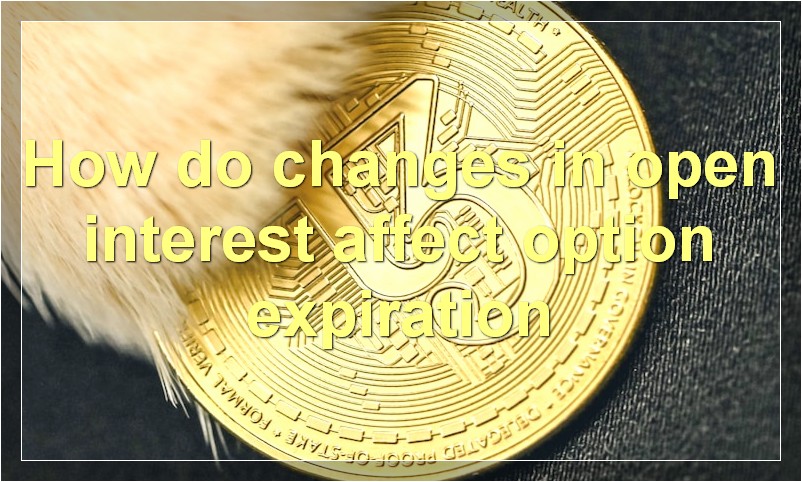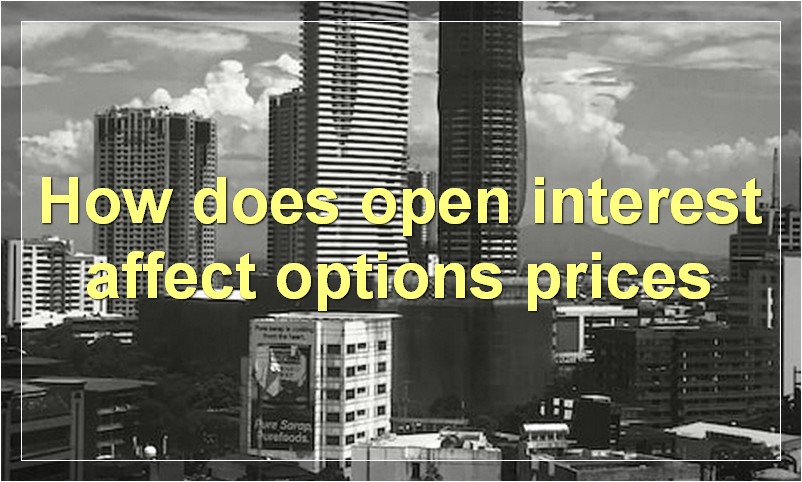If you’re an options trader, it’s important to understand open interest. Here’s everything you need to know about this key market metric.
How is open interest calculated for options contracts
When it comes to options contracts, open interest is calculated by taking the total number of outstanding contracts and subtracting the number of closed contracts. This number can be a positive or negative value, but it is typically a positive value since there are more new contracts being created than there are old contracts being closed. The open interest for an options contract represents the total number of contracts that are still active and have not been exercised or expired.
How does open interest affect options prices

Open interest is the number of outstanding contracts that are held by traders. It is a measure of market activity and liquidity, and it can have a significant impact on options prices.
When open interest is high, there are more traders active in the market and there is more liquidity, which can lead to lower prices for options contracts. Conversely, when open interest is low, there are fewer traders active in the market and there is less liquidity, which can lead to higher prices for options contracts.
Open interest can also be used to gauge market sentiment. If open interest is increasing, it may be an indication that traders are bullish on the market. Conversely, if open interest is decreasing, it may be an indication that traders are bearish on the market.
What is the difference between open interest and volume for options trading
Open interest and volume are two important metrics when it comes to options trading. Open interest represents the number of open contracts for a particular option, while volume represents the number of contracts traded for that option. While both metrics can provide valuable information to traders, they measure different aspects of options activity.
Open interest is a good metric to track because it can give you an idea of the level of interest in a particular option. If there is high open interest, it means that there are a lot of people interested in that option and it might be worth paying attention to. Volume, on the other hand, is a good metric to track because it can give you an idea of how active the market is for that particular option. If there is high volume, it means that there is a lot of trading activity and you might be able to get a better price for your option.
Is there a relationship between open interest and liquidity in the options market
There is no definitive answer to whether there is a relationship between open interest and liquidity in the options market. Some traders believe that higher levels of open interest equate to more liquidity, while others contend that it is the other way around. Ultimately, it is up to each individual trader to determine what factors they believe contribute to liquidity in the options market.
How can open interest be used to gauge trader sentiment in the options market
Open interest is the number of contracts of a particular security that have been traded but not yet closed. It is a good indicator of market activity and can be used to gauge trader sentiment in the options market.
For example, if open interest in a particular stock’s call options is increasing, it could be an indication that traders are bullish on the stock. Conversely, if open interest in the stock’s put options is increasing, it could be an indication that traders are bearish on the stock.
How do changes in open interest affect option expiration

Open interest is the number of outstanding contracts for a particular security. It is a key metric for options traders to watch because it can give them important clues about market sentiment and the potential for future price movement.
When open interest is declining, it means that fewer new contracts are being created and that existing contracts are being closed. This can be an indication that traders are losing confidence in the direction of the market and are beginning to take profits or exit positions.
If open interest is increasing, it means that more new contracts are being created than are being closed. This is generally seen as a bullish sign, as it indicates that traders are confident about the direction of the market and are willing to commit to new positions.
Changes in open interest can also give important clues about the expiration of options contracts. If open interest is declining sharply in the days leading up to expiration, it may be an indication that traders are nervous about the prospects for the underlying security and are unwinding positions. Conversely, if open interest is increasing in the days leading up to expiration, it may be an indication that traders are confident about the outlook for the underlying security and are holding onto their positions.
What factors can cause open interest to increase or decrease for options contracts
When it comes to options contracts, open interest is the number of outstanding contracts that have not yet been exercised or expired. This number can fluctuate based on a few different factors.
For instance, if there is an expiration date approaching and the market is bullish, more traders will likely buy call options than put options. This would cause the open interest for call options to increase, while the open interest for put options would decrease.
Another factor that can affect open interest is the level of liquidity in the market. If there are more buyers than sellers, this can cause the open interest for a particular option to increase. However, if there are more sellers than buyers, this can cause the open interest to decrease.
Finally, news events can also impact open interest. If there is positive news surrounding a particular stock, this could lead to an increase in the open interest for its corresponding options contract. However, if there is negative news surrounding a stock, this could lead to a decrease in the open interest for its corresponding options contract.
How do institutions use open interest when trading options
Open interest is the number of contracts that are held by traders and not yet closed. When open interest increases, it means that more traders are entering the market and buying options contracts. This is usually seen as a bullish sign, as it indicates that more traders are expecting the price of the underlying asset to rise.
Institutions often use open interest to gauge market sentiment and make trading decisions. If they see that open interest is increasing, they may buy more options contracts in order to profit from the expected price increase. On the other hand, if they see that open interest is decreasing, they may sell their options contracts in order to avoid losses.
Open interest can also be used to confirm price movements. For example, if the price of an asset starts to rise and open interest increases at the same time, this is a strong indication that the price move is genuine and is likely to continue.
How does open interest impact the Greeks for options trading
Open interest is the number of outstanding contracts that exist for a particular security. For options trading, open interest can impact the Greeks in a few ways.
First, open interest can affect the liquidity of an options contract. If there are a lot of outstanding contracts, it may be easier to trade the contract and get a good price. If there are few outstanding contracts, it may be harder to trade the contract and you may have to pay a higher price.
Second, open interest can affect the delta of an options contract. Delta measures how much the price of the contract will move if the underlying security moves by 1 point. A higher open interest usually means a higher delta, because there are more contracts out there that will need to be bought or sold as the underlying security moves.
Finally, open interest can affect the vega of an options contract. Vega measures how much the price of the contract will move if there is a 1% change in implied volatility. A higher open interest means a higher vega, because there are more contracts that will be affected by a change in volatility.
What other indicators can be used in conjunction with open interest when trading options
When trading options, open interest is just one indicator that can be used to make decisions. Other indicators that can be helpful include volume, implied volatility, and the option’s delta. By looking at multiple indicators, traders can get a better sense of what is happening in the market and make more informed decisions.

